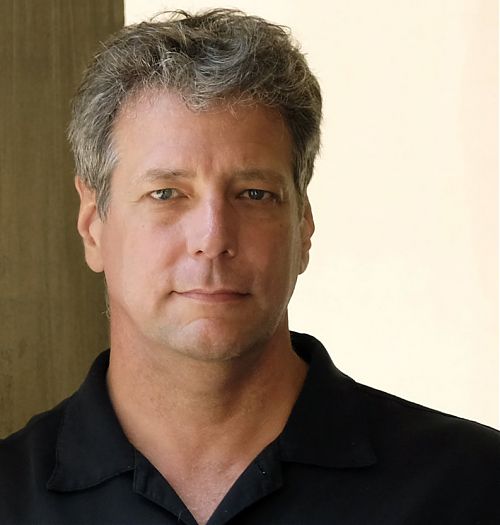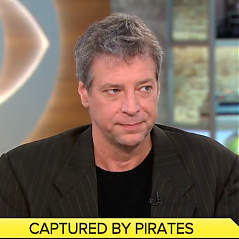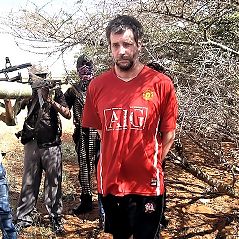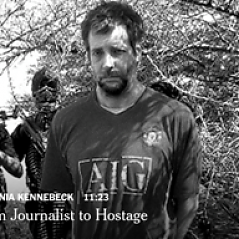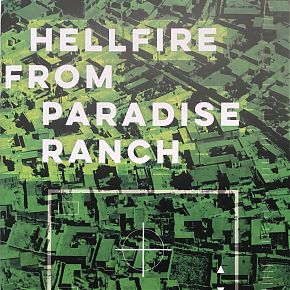“Our People”
The Somali refugees living in a small meatpacking town in southwestern Kansas loved America. So did the three local men who wanted to kill them.
February 2019
In the grandeur of a Wichita courtroom, in the spring of 2018, three defendants in prison jumpsuits stood trial for conspiring to blow up an apartment complex in Garden City, Kansas, which was home to many Somalis. Curtis Allen, 50, Gavin Wright, 52, and the alleged ringleader, Patrick Stein, 49, had talked about planting fertilizer bombs in trucks at the corners of the building. It was the same method favored by al-Qaida terrorists, but the men saw themselves as defenders of an American way of life. They believed Obama was “really” Muslim, and they mistrusted the Muslims they saw in the meatpacking region of western Kansas, which has become a magnet for immigrants and refugees. The attack was planned for the day after the election to avoid throwing the contest to Hillary Clinton. The FBI rounded them up in October 2016, with a month to spare.
The story had a special resonance for me. I was kidnapped by pirates on a reporting trip to Somalia and spent 32 months as a hostage. I knew what it meant to hate Somalis, and I knew the intolerant side of Islam. But I also knew that hatred was a dead end, a suicidal urge, and after suffering a bitter season of hatred in a distant land — aimed at me, because I was an outsider — I became curious about violent nationalist tendencies in the United States. I wanted to understand the unique dynamics of a diverse town in the Midwest. I’d been gone for a while, and you might even say I felt ignorant about my own country. So I bought a ticket and flew to Kansas.
§
I landed in Garden City during a freak blizzard in the spring of 2017. Howling wind knocked down power lines, sheared massive boughs off trees in front of shingled, porch-fronted bungalows, and killed thousands of cows. I had arranged to meet Ahmed Hassan Ali. He was drinking tea at a place called the African Shop, where you could buy sticky dates and sorghum flour for anjero pancakes in the front room and find hot meals and soccer on TV in the back. Located half a mile from the apartment complex the three defendants targeted, it was a community center, a place to socialize. Most Somalis would have felt out of place in a Kansas sports bar.
Ahmed said he was 37. He seemed younger, with a trim haircut and an easy smile, which he flashed as he recounted how he came to live in Kansas. His family had been fractured by the Somali civil war. He’d left his hometown of Mogadishu in 2005, when he was 25. “When the war happened, everybody was trying to save himself,” he said. “My mom and my dad passed away while I was out of the country.”
He followed the same path in 2005 that refugees made famous 10 years later, a migrant trail toward the Mediterranean. “First I went to Ethiopia. I stayed there like six or seven months,” Ahmed said. “I couldn’t work, because there’s no work there.” So he fell in with a group of Somalis and lived with them for a while in the smoky, tree-grown metropolis of Addis Ababa. “We paid a guy to go across the border, and then we came to Sudan, Khartoum,” he said. They rode on dusty smuggling paths in tottering flatbed trucks. “We were at the back of the pickup, close to 30 people,” he said. “And if someone fell off, the driver wouldn’t even stop. That person would die in the desert. That’s the rules.”
The journey across Sudan, from Addis Ababa to Cairo, took three months. (“We don’t have a map or anything, so we asked the people, like town to town, how to reach there.”) He spent a couple years in Egypt without finding work, then moved to Libya with the ambition of crossing to Europe. “We tried to get a boat to cross the Mediterranean,” Ahmed said. “But we didn’t make it. We were 172 people. Only nine persons survived.”
“Oh my God,” I said. “Including you.”
“Yah. I am one of the survivors,” he said. “We were on the water nine days.”
A ship from Greece pulled them out. The crew dried off the survivors and returned them to Libya as illegal immigrants. “We go back to Libya, and they put us in prison. We were in prison nine months because we broke the law.”
After his release, Ahmed had no desire to board another dinghy, so he moved back to Cairo and stayed 11 more years. “I had no passport in Egypt, no papers. I just walked over the border. I went to UNHCR [the United Nations High Commissioner for Refugees] in Cairo and said, ‘I’m Somali. I have no document. I just got here.’ They got a guy to interview me in the Somali language to verify what I’m saying. And they gave me an ID so I could stay.”
In 2008, Ahmed earned a certificate in English from the American University of Cairo and started to translate for outfits like the UNHCR and the International Organization on Migration. “I had a lot of friends who were already in America,” he said, and he wanted to come too. Ahmed was realistic about his ambitions, but he “thought it was a place,” unlike Somalia, “where I would live and die peacefully.”
Ahmed applied for U.S. asylum in 2009. He was accepted in 2015. He mentioned a Somali friend who had already reached Garden City, named Mursal Naleye, and after a screening process, Ahmed was flown from Cairo straight to Dallas, and then to Garden City. He joined his friend Mursal at the Tyson slaughterhouse and has worked there ever since.
Somalis live in the meatpacking triangle of southwestern Kansas — which extends across the grassy Kansas flatlands from Dodge City, through Garden City to the west, and south toward Liberal on the Oklahoma border — because slaughtering animals is such intense and dangerous work that no one else will take the jobs. Immigrants have dominated U.S. slaughter lines here for decades; before Somalis, there were waves of Cambodian, Laotian, Burmese, Vietnamese, and Latino workers.
Garden City’s particular mix of ethnicities stretches back to 1970, when the county was weighing a proposal to open a major meatpacking plant here. There were fears among county leaders that the low-wage workers it attracted would change the town’s complexion. Sister Janice Thome, an activist and Catholic nun, said church leaders and politicians recognized that these newcomers might need welfare; they might need support. The leaders deliberated, asking, “Are we gonna call ’em a blessing or a curse?” Sister Thome told me. “And they decided: blessing.”
In 1980, Iowa Beef Processors (IBP) opened the world’s largest slaughterhouse and meatpacking factory in Holcomb, seven miles west of Garden City. President Jimmy Carter had recently approved a plan to allow refugees from the Vietnam War, so-called boat people, to claim asylum from abroad and find resettlement around the United States, so Cambodian and Vietnamese workers came to live among Garden City’s white and Latino population. Pho restaurants opened downtown.
Tyson bought IBP in 2001, and the first group of Somalis followed about five years later. Today, Ahmed said, Somalis make up nearly the entire second shift at Tyson, which is known to have some of the best-paid nonunion meatpacking jobs in the country. Ahmed told me he’s heard that Somali meatpackers work for “like 10, eight, nine dollars” per hour in Buffalo, New York. “But the starting rate here is like 16!” he said. “Everybody wants to get $16 an hour.”
Ahmed likes his job. Management gave some concessions to workers, even though they’re not unionized, including prayer breaks for Muslims, sometimes twice per shift. When he was seriously injured on the line, Ahmed said Tyson paid the whole medical bill. “It’s a great place to work,” he said with a smile. “I feel Tyson is like part of my family. It’s the only place I can work where I get no problem.”
§
One dimension of the ongoing Somali civil war involves a bitter struggle with al-Shabab, a group of Qaida-aligned terrorists. Most Somali adults who apply for asylum in North America want to escape both the civil war and al-Shabab. But a handful of their children have taken it into their heads to join al-Shabab, or even the Islamic State. Shirwa Ahmed, for example — who went to high school in Minnesota and became a naturalized citizen — left the United States in about 2007 and, in late 2008, became al-Shabab’s first American suicide bomber. Another young Somali, Dahir Adan, born in Kenya but raised in the United States for 15 years, knifed nine people in a Minnesota mall in September 2016. None of the victims died, though Adan was shot and killed — and the Islamic State claimed him as a martyr.
These incidents grabbed the attention of Patrick Stein, a thick-shouldered farmer from a hamlet near Dodge — raised Catholic, born in 1969 — who spoke with a prairie twang. By 2016, he started shooting on a regular basis with the Southwest Kansas Three Percent, a militia movement. During a field exercise with the group in February 2016, Stein met a man named Dan Day.
At that time, Day was known within militia circles for posting a picture of a flyer that he claimed had been hung on a bulletin board at the Finney County Public Library, in Garden City. It showed a Palestinian flag and criticized Israel: “End the apartheid.” Day said he ripped down the paper and wrote something defiant on Facebook against the library for supporting Muslims. The post went viral. Day’s story is confusing and sometimes inconsistent, and, a librarian told me, “It had absolutely zero to do with Garden City, or Finney County Public Library, except that [someone on Facebook] said it was here.”
The post created a game of online telephone, a blurry-minded rumor mill that led some militia members in Kansas, including Stein, to believe the library had circulated recruitment brochures for ISIS. Stein also heard a rumor from Day that slaughterhouse work among Somalis covered up a more sinister business: a wild and unlikely scheme to raise funds for ISIS through Mexican drug cartels. The stories pissed Stein off.
“When we have ISIS in our community, we’re damn well gonna defend ourselves,” he told me in a prison interview in the spring of 2018. “If you know anything about Islam, you know they’re not our friends. If you’re Christian, you’re an enemy. You’re an infidel. They might smile and everything, but when it comes down to it, they’re not our friends.”
Stein has a notorious temper, and his own lawyers later filed a brief arguing that his hard-luck life and the tone of Trump’s 2016 presidential campaign left him susceptible to bigoted rhetoric about Muslims. “Patrick’s knowledge of the Quran, the Muslim holy book, came directly from the internet and conservative talk-show hosts such as Sean Hannity and Michael Savage,” his lawyers wrote in a bid for mercy. “A person normally at a 3 on a scale of political talk might have found themselves at a 7 during the election. A person, like Patrick, who would often be at a 7 during a normal day, might ‘go to 11.’”
Stein also had a known history of meth use. He and one of his co-conspirators, Gavin Wright, bragged to federal officials about their capacity to cook and sell a good batch. (“I’m smarter and didn’t get caught,” Wright said on tape, according to the FBI.) The drug can inflame a person’s temper and cause paranoia. Stein was also an alcoholic, and if you mix his chemical predilections with his paranoid fantasies about immigrants and Islam, you start to understand his behavior.
§
Among the three defendants, Curtis Allen was the only military veteran, which gave him some authority in militia circles. Born in Oklahoma and raised in western Kansas, he enlisted in the Marines out of high school in 1985 and returned to the military, off and on, over the next 20 years. Allen moved from the Marines to the Kansas Army National Guard. He saw his first overseas firefights as a lieutenant in the National Guard during the Iraq War, managing security for truck convoys in Iraq. He came home from that tour with PTSD-related symptoms, including narcolepsy and paranoia, which ended his military career.
“He had a hard time holding jobs for any length of time,” his brother Kevin told me. “He gets a government check because of it.”
Lula “Donnette” Harris, Allen’s longtime girlfriend, was more vivid. “He liked me to stay overnight, because if I didn’t, he would find himself in the middle of the night in the corner of the bed, at the back of the wall, with a gun, and he wouldn’t sleep,” she told me. “He had bad paranoia.” It flared in every direction: “He was afraid that Obama in some way was gonna get martial law, that he was gonna be the last president… [and that] martial law would then become Sharia law,” Donnette said.
She met Allen in Wichita in 2006. They moved to Liberal, Kansas, in early 2014 to settle in the Sage Mobile Home Park, a well-ordered lot with a handful of trees and several dozen trailers arranged in two loops of dusty road. The couple “prepped” in the trailer: They stockpiled weapons. They ordered solar panels. They canned vegetables and fruits and jellies and meat. Donnette made quilts. “We had always been preppers,” she told me, and Allen wanted to live in a remote town like Liberal, rather than a larger city like Wichita, precisely because he thought a small town might be safer in case of a major blackout or a military strike.
Allen opened a retail shop there for Alder Home Security, an alarm system company. When the shop closed, he became a traveling salesman for Alder out of his mobile home. He also had a title—first division commander — in a well-established militia called the Kansas Security Force (KSF). The KSF regarded itself as a defensive militia connected to the so-called Three Percenters, a loose nationwide affiliation of militia movements.
In 2015, Allen met Patrick Stein. The pair hit it off, and Allen eventually convinced Stein to leave the Southwest Kansas Three Percent and join the KSF. “Stein joined because we were better organized,” Allen told me. “We went out and shot weekly.”
Dan Day, in turn, followed Stein to the KSF. The others weren’t sure what to think of Day, who seemed portly and out of shape. “I thought Dan Day was a fuckin’ cop the whole time,” Allen said. In fact, unknown to all the men, Day was a paid FBI informant who had shifted his attention from the Southwest Kansas Three Percent to Stein and his friends. Despite his reservations, Allen allowed Day into an inner circle, a splinter group from the KSF that came to be known as the Crusaders.
§
The third conspirator, Gavin Wright, grew up right in Garden City. He went to Garden City High School, and his brother Garrett still runs a successful mobile home business on the southwestern edge of the city called D&H Homes, which their father established in 1971.
Wright spent his adult life in other parts of Kansas, raising a family and running an electrical business in the town of Manhattan, for example. After his father died, in 2013, he returned to Liberal and raised one of his teenagers in a pleasant, leafy neighborhood while he and his brother established a new modular home business called G&G Home Center. The G&G office itself was a white modular home, assembled on a rise of grass on the north edge of Liberal, looking out on the windy, half-cultivated Kansas prairie toward Garden City.
Wright’s trouble started when Curtis Allen knocked at the door of G&G sometime in 2015 to sell him a home security system. The men struck up a friendship, and Wright even gave Allen a sales job at G&G. Allen worked his own influence on the boss: “Gavin started to prep after meeting Curtis,” said Donnette, who took some credit of her own for nudging Wright in that direction. “Him and I would have conversations, and he would say, ‘Oh my gosh, I never thought about that.’”
G&G never flourished. By the end of 2015, Wright had moved with his son to a modular home just a few miles away, across the Oklahoma border, where he started to stockpile weapons, food, and survival equipment. Wright’s lawyer in Wichita painted him as a “very lonely man,” a semi-recluse who grew vulnerable to new, unsavory relationships, and his friendship with Allen did seem to mark a difference between Wright’s life in town and his life in Oklahoma.
By mid-2016, the vinyl-sided G&G office became a regular meeting spot for all four men (including Dan Day). They turned off their mobile phones; they played loud music to mask their voices; they talked about prepping and how to shift the United States from its current unfortunate trajectory. They uttered hard words about Muslims, but, according to Allen, the talk never rose above that. “Me and Gavin and Patrick were doing prepping meetings,” he said. “Stein brought Dan Day in. He interjected the whole bombing attack.”
To keep in touch outside their meetings, they used a phone app called Zello, which lets a phone behave like a walkie-talkie. Curtis Allen’s nickname on Zello was “Commander.” Patrick Stein’s was sometimes “orkinmanIII%” and sometimes “XO,” or Executive Officer — second in command. Gavin Wright went by “Sparky1943,” allegedly because of his electrical expertise. Stein gave their conversations a title: “The Crusaders.”
In prison, Stein tried to convince me that the topic of those conversations amounted to defensive measures, not a specific plot to bomb Somali immigrants. He said he worried about a complete breakdown of U.S. order after Election Day 2016, regardless of who won. “We had intel that it didn’t matter who won the election. Antifa and Black Lives Matter were gonna start burnin’ things down from coast to coast if Trump won.” And if Hillary won, Trump supporters would do the same thing, he’d heard. As a militia, Stein said, “we had to prepare for either way it went.”
But his story parted from Allen’s, because Allen told me from jail that Trump’s victory had taken him by surprise. “It annulled the whole plan,” he said.
He denied fearing a civil war in case of a Republican win. He also didn’t recognize the word “Antifa.”
“What I worried about was an EMP attack,” Allen told me.
“A what?”
“Electromagnetic pulse.”
During a nuclear war, apparently, there would be a real and serious risk of damage to U.S. infrastructure, beyond the blast radius of a warhead, from an electromagnetic pulse. Nuclear scientists agree that it could knock out vast parts of the country’s electrical grid. What they don’t take seriously is the notion of a non-nuclear EMP attack, let’s say by North Korea. Most experts consider it highly implausible, but some wings of the Republican establishment — including the Heritage Foundation, a think tank — treat an EMP attack as a serious risk.
“Curtis was very much into watching Alex Jones,” Donnette said. “I would love to get on [Jones’] show just to tell him, ‘Hey, look at one of your biggest fans who listens to your garbage.’” She added, “Curtis was very gullible to a lot of things going on. A lotta YouTube. Like I told him, anyone can put anything on YouTube. It’s 10 times worse than Facebook.”
§
Ahmed showed me around Garden City. He said he’d spent a lot of time hanging out in the Mary Street complex — the target of the Crusaders’ plot — but he lived in an apartment on the east side of town, about two miles away, owned by the same landlords. It was a gloomy bachelor pad with brownish curtains and strings of bright little colored lights across one wall. We took off our shoes on a square of linoleum just inside the door.
“We don’t got a lady to clean!” Ahmed said with a laugh. “You know? That’s why we take off our shoes.”
Ahmed offered me a cup of cardamom-flavored tea. His roommate, Mursal, came out to sit on a mat on the kitchen floor. Mursal had a thin line of facial hair down each cheek and fervent brown eyes. He wore a white tank top, which he’d slept in, as well as a skirt-like sarong around his waist — a garment associated with Sufi Islam, which is common enough in Somalia, though not in Kansas.
Both Ahmed and Mursal have worked at the Tyson plant, carving and packing beef. Western Kansas is beef country. I asked if there was any risk of packing pork, and Ahmed shrugged.
“Even if it’s pork, I’m okay with that. But some people would not accept.”
Mursal shook his head. “No,” he said. “For the religion, you can’t work with pork.”
“Really? Come on, man.”
“How you gonna work if you can’t even touch it?” Mursal said.
“I understand eating pork is against the Islamic religion,” Ahmed said. “I got that.”
“But making money on it—”
“But making money on it, at work, I’m not eating it,” Ahmed said. “Other people cut it, or kill it, or take the skin off, but — ”
“Even if you touch it, you have to wash your hand nine times.”
“That’s for the dog,” Ahmed said.
“No, the dog is seven times,” Mursal said. “The pork is nine times.”
“Come on, man. This is new to me, the information you’re giving me. What I know is, that’s the dog.”
“The dog is seven times,” Mursal said.
Mursal was a prominent citizen in Garden City who acted as a go-between for the Somalis and the local government. His role arose from an incident in 2015, when a Somali died in a car accident. The body needed a Muslim burial. “But around here, we don’t have no cemeteries,” Mursal said. “And we have to bury them within 24 hours. It’s very difficult.” There was a Muslim cemetery in Wichita, “but a dead person carried in a car for four hours, that’s gonna be a big problem,” Mursal said. With his strong command of English, Mursal helped find a refrigerated car to transport the deceased. “It took like a day and a half, but the person was buried, finally,” he said.
In 2016, when the community decided to create a local parliament — a group called the East African Community Center — to help deal with such issues, they elected Mursal as its leader. Somalis trusted him to figure things out. “I know a little bit about the city and how the system works,” Mursal said with evident pride. “And I have a lotta people who can help me.”
§
Patrick Stein was firing weapons one day in June 2016, with Dan Day and another militia-minded Kansan named Brody Benson, on Benson’s property near a town called Partridge. The date was June 14, two days after the Pulse nightclub massacre in Florida, where Omar Mateen shot 49 people dead. Benson and Stein were hopping mad. “They’ve got these apartment complexes over there [in Garden City] where literally every fucking apartment… that’s all it is, fucking goddamn cockroaches,” Stein said while Dan Day stood near him with a recording device. “I mean, I wouldn’t be against if I could get ahold of some RPGs [rocket-propelled grenades], I’ll run some RPGs right through… I’ll blow every goddamn building up right there… boom… I’m outta there.”
Stein and Benson considered all Muslim immigrants a threat to the United States.
“I was never shy as far as talking about Islam,” Benson later said in court, explaining a profane sentence he’d posted around the same time on Facebook. But he said Stein took on a new tone at the shooting range that “made me very concerned… I actually thought it was not just talk. It was more of an actual action.” Benson told the court that Stein had wanted to recruit people to murder Somalis, and the conversation had moved Benson to resign from the Kansas Security Force. “After that meeting, I was done,” he said. “I was out.”
Stein’s lawyers argued that his inflammatory talk that day was offensive but protected speech. But the feds had pages of transcripts from the splinter group at G&G, including transcripts from their Zello exchanges. The pile of evidence showed talk that went far beyond skepticism about Muslim immigration to the West. They downloaded and printed thousands of pages of manuals about homemade explosives, and Allen watched bomb-making videos on YouTube until Donnette could recite the steps by heart.
One day in September 2016, Donnette stopped by the G&G trailer and found Wright and Allen cooking a thick white liquid on the kitchen stove. Because of the YouTube videos, she recognized homemade hexamethylene triperoxide diamine (HMTD), a volatile compound useful for blasting caps in large, crude fertilizer bombs like the one Timothy McVeigh built in 1995 in his attack on the Alfred P. Murrah Federal Building in Oklahoma City.
“I was floored,” Donnette told me. “I thought, ‘Wow, you’re actually — you’ve taken this further than just watching these videos in the evening.’”
A few days later, at a remote truck stop between Garden City and Liberal, Curtis Allen ignited a tiny amount of HMTD powder as an experiment. It blew a one-inch hole in the asphalt, and Gavin Wright felt the concussion from several yards away.
“It blew up pretty good!” he shouted.
Donnette understood what the men were doing now, but she felt conflicted about her relationship with Allen. They had plans for a retirement in some distant place, Alaska or Colorado, far off the grid, she told me — and she had been diagnosed with cancer, so a life without Allen seemed unimaginable.
Nevertheless, things came to a head on October 11, she said, when Allen roughed her up in a spat over a puppy. “We had words, and he said, ‘I’ll just go out there and kill the dog.’ I said, ‘You kill that dog and I’ll call 911 on you,’” she told me. “Then he fought me for my phone, and I wasn’t givin’ it up, so he bruised me and gave me some abrasions on my hand.” Allen had been convicted of domestic violence on Donnette once before. “I really felt, if I don’t get out now,” she said, “I wasn’t leaving.”
So Donnette called the cops. Police arrested Allen the same afternoon. They also paid a visit to his trailer. Donnette showed them his stockpiled weapons, and the cops — unaware of the federal investigation already underway — nailed him for felony gun possession as well.
The startled FBI then accelerated a planned sting operation to net Patrick Stein. Through Dan Day, they arranged a deal with an undercover “bomb expert” who could build explosives using Stein’s own stash of ammonium nitrate, a volatile fertilizer. Stein offered to pay for this service in cash and crystal meth, an agreement that was caught on tape.
On October 14, the FBI arrested Stein near a McDonald’s in Dodge City for conspiracy to use a weapon of mass destruction. They arrested Gavin Wright on the same day, on similar charges, outside the G&G office in Liberal.
Donnette told me with some wryness about a lawyer from Curtis Allen’s team who paid her a visit before the trial. “That attorney was like, ‘Curtis couldn’t have done this,’ and I was like, ‘What are you talking about?’” she said. “Curtis was a mechanic. Gavin Wright was an electrician. Patrick Stein’s family was into farming [and had access to fertilizer]. I mean, there’s a bomb right there between the three of them.”
The Crusaders were no more, and the three men stood before a federal judge the next week. Only one conspirator was absent: the informant, Dan Day.
§
When the news broke across the United States, Garden City on the whole reacted with revulsion. Police Chief Michael Utz met with Mursal and other prominent Somalis to let them know about the story before the headlines came out. About a week after the arrests, locals organized a candlelight march along Mary Street consisting of around 250 people. “Several residents from both apartment complexes came out and joined,” said Utz, who helped make signs for the march. “It was an awesome sight. It’s who we are in Garden City.”
I heard this sentiment over and over — that anti-Muslim feeling doesn’t belong in Garden City, or somehow comes from outside. “There’s a hospitality here and a tradition of taking care of strangers,” said Bill Clifford, an ophthalmologist who chairs the Finney County Republican Committee. “The Somalis do stick out, but they’re our people now, and that’s why people were up in arms — very, very defensive about ‘how dare they come in here and try to hurt our people?’”
§
After 17 months of preparation, the trial opened in Wichita in March 2018. The men were accused of conspiracy to use a weapon of mass destruction, as well as conspiracy against civil rights — namely the Somalis’ right to live where they pleased. Together, these charges amounted to a charge of domestic terrorism. (Gavin Wright also faced a charge of lying to the FBI.) The trial turned on the question of entrapment. Dan Day had worked as a paid informant, so the defense asked whether the three men had plotted under their own initiative to murder Somalis. Or had Day led them on?
All the defendants had salty mouths, their lawyers maintained, but none of them spoke seriously about shooting Somalis, or blowing up their apartments, until Day had planted the idea in Patrick Stein’s head. “The FBI created and directed all this,” argued Rich Federico, one of the public defenders, in opening remarks to defend Curtis Allen. He dismissed the men’s foul language as “locker room talk” and suggested the feds had targeted the defendants for constitutionally protected free speech.
The judge, Eric Melgren, a George W. Bush appointee, made it clear to his jury that prosecutors had the burden of proof: They had to show that suspects followed by the FBI would have formed their plot even if a decoy had not been floating in the pond. But prosecutors had the preponderance of evidence, including a notebook discovered in Allen’s trailer after his arrest. The men had collaborated on a draft manifesto for the coming violence. “Standing up for the Constitution is not domestic terrorism,” Allen had scribbled. “We have to take a stand… We are trying to do just that with this manifest. We know what’s going on. This is a wake up call to everyone else… This is a call to action by all Americans. Please do not just sit idle until we lose this once great nation.”
The jury took about seven hours to deliberate and found them guilty the following day. With Day’s involvement, according to the convictions — and under Day’s surveillance — Allen, Stein, and Wright planned a paramilitary assault on the Mary Street apartments that would not just kill Somali immigrants and blow up their mosque, but also serve as an Oklahoma City–style “wake-up call” and trigger copycat violence around the United States.
The prosecutors would seek life in prison for each defendant. But the case would take nine months to resume.
After the sentencing, I saw Ahmed again and asked him his opinion. He said something remarkable. He said he hoped the Crusaders would get only three to four years in jail. He wished for their rehabilitation. “Because in America, you get a second chance. We came here from a country where life is very hard. We work hard, we follow the rules, we get respect. We get a second chance. So those guys should get one too.”
§
The court reconvened on January 25, 2019, to sentence the men. Prosecutors played video of a half-dozen Somalis from the Mary Street apartments explaining how the bomb threat made them feel. “I grew up in civil war,” said Ifrah Farah, a woman wearing maroon hijab. “I’m shaking. Right now I’m feeling this feeling. We need peace.” She directed her last words at the three men sitting across from the video screen, wearing prison jumpsuits and ankle chains. “Please don’t kill us. Please don’t hate us. We can’t hurt you,” she said.
Judge Melgren spent most of the day considering arguments from lawyers, but he let each defendant, in turn, give a final statement. Curtis Allen surprised everyone by apologizing. “I’m just ashamed of myself, and I’m sorry,” he said and broke down in tears. Rich Federico, one of his lawyers, read his statement. Allen had watched the bomb plot develop and now understands he should have shut it down. “I’m smarter than this,” the statement read.
The judge declined to sentence Allen to life in prison. For the first count of conspiracy to use a weapon of mass destruction, he gave Allen 25 years. For the second count — conspiracy against civil rights — he ordered 10 years, to be served concurrently. The judge admitted that a sentence of two and a half decades was not very different from a life sentence to a man now 51 years of age. But he also felt the racist component of the crime made it worse, in conception, than the Oklahoma City bombing. “Race, religion, and national origin are the very types of things that this republic safeguards,” Judge Melgren said.
Patrick Stein stood up in court and apologized to his assembled family and friends for the “literal hell” he had put them through, including damage to the Stein family name. He claimed responsibility for his own actions, adding that the ordeal of the trial had been, “for me, a personal hell on earth.” He said, “I’ve learned valuable lessons over the last 28 months, and I don’t plan on revisiting any of the events that brought me here today.”
Stein hadn’t mentioned Mary Street, Somalis, Garden City, or Muslims. Judge Melgren noted his lack of contrition and sentenced him to 30 years, saying that although Stein had not met the standard of “legal organizer” of the group, “he was extraordinarily enthusiastic about this event.” (Stein’s defense team recently announced plans to appeal.)
Gavin Wright, shown by his lawyers to have been marginally less involved in the plot, also gave a statement that fell short of contrition. “I wanna apologize to the court, because that’s not who I am,” he said. “And I’d like to apologize to the people of 312 Mary Street, because that’s not who I am — and they’ve painted me to be something I’m not.”
The judge gave him 25 years and added one more for lying to the FBI. “To the extent that he was in it less, he also showed no remorse,” Judge Melgren said.
§
I returned to Garden City the next day. Patches of snow lay on the ground, and the city’s mood felt quiet and Kansas calm, though the African Shop on Mary Street was bustling. A young Somali woman with cat-eye glasses and a pink headscarf, named Ifrah Ahmed, said she lived in the once-threatened complex down the street. I asked her how she felt.
“How do I feel? Relieved,” she said. “But in a way, I knew it would come out this way, because I knew the court would do what was right.”
Ahmed, however, was astonished. He hadn’t heard about the sentences before I met him at the shop. He thought the men would not have to spend decades and decades in jail. “We are human,” he said. “Humans make mistakes.” The shop owner, Aden Ibrahim Knaan — a bearded man with glasses who lived in the Mary Street complex — disagreed. “You and I, we have a difference of opinion,” he said. “What happened to these guys, that’s the law of the state. And that’s how it is. What we say now will not make much difference.”
“To me,” Ahmed said, “I wish they got like five, seven — but 25 years? It’s a lot.”
“Imagine, they were planning to hurt a hundred people. God save us,” Aden said in Somali. “The government is protecting us, and we are thankful.”
Several people at the African Shop said relations were better now between Somalis and the rest of Garden City, because after the plot was revealed, some locals went out of their way to meet the newish immigrants. But Aden admitted that he still mistrusted strangers who came into his shop. I had noticed that myself — a white face in the African Shop inspired mild tension until you said you had an “appointment” with a known Somali.
Ahmed mentioned that Police Chief Utz’s preemptive friendship campaign helped keep Garden City from fracturing. “Now we trust the police!” he said. “But when I heard this story the first time, I said to myself, ‘What is going on? You left from a place of violence — bombs and guns, people getting killed — and it follows you to the United States? A place where you thought you would live and die peacefully?’” Ahmed gave an incredulous smile. “That was so surprising to me.”
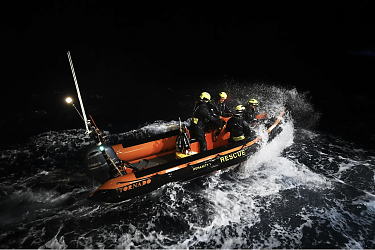
Rafts of the Medusa
Why every day on the Mediterranean is a new scandal for Europe. For both Foreign Policy and Die Zeit.
California’s Attempt at Land Reparations
How land seized from a Black family 100 years ago may be returned. The Bruce’s Beach story from a hometown angle, for The New Yorker
Day of the Oprichnik, 16 Years Later
The novelist Sorokin, the president Putin, his man Dugin, and the war in Ukraine. For n + 1.

The Rushdie Narrative
Knife and the crumbling ground beneath free speech
There Must Be Some Way Out of Here
An essay on Bob Dylan, “All Along the Watchtower,” and Somali pirate captivity.
That Mystic Shit
The life of Lou Reed in two biographies
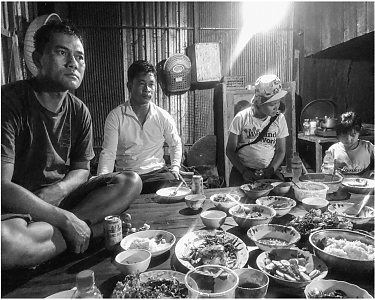
Cambodian Seafarers Talk About Pirates
Mike visits Cambodia for The New Yorker to talk about a harrowing shared experience in Somalia
The Muslim Burial
Cambodian hostages remember digging a grave for one of their own. A sequel chapter to The Desert and the Sea
The Real Pirates of the Caribbean
Adventure journalism in Southern California. A travel essay for The Paris Review.
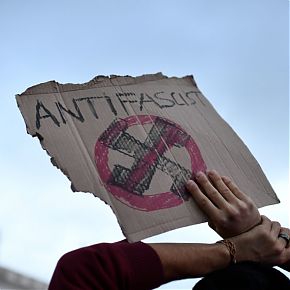
Antifa Dust
An essay on anti-fascism in Europe and the U.S., for the Los Angeles Review of Books
Was Hitler a Man of the Left?
A book that helped Republicans in America lose their damn minds.
Ghosts of Dresden
The Allied firebombing of Dresden in 1945 destroyed the baroque center of what Pfc. Kurt Vonnegut called, in a letter home from Germany, “possibly the world’s most beautiful city.”

George Freeth, Biographed
The first academic treatment of America’s surf pioneer. Also, was Freeth gay?
It’s Called Soccer
Americans live on what amounts to an enormous island, defended on two shores by the sea, and we’ve evolved a few marsupial traditions that nobody else understands.
Tilting at Turbines (in the Severn River)
The morning was clear and cold, with frost on the church steeple and the cemetery grass. I had a quick English breakfast at a white-cloth table, in my wetsuit, and drove to Newnham, a village on the Severn River in Gloucestershire, parking near the White Hart Inn.

The Curse of El Rojo
I’d packed the car lightly — a bag of clothes, a bag of cassette tapes, a backpack of books, a few essential tools.










